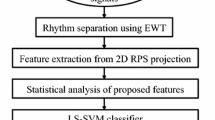As is known, Alzheimer’s disease (AD) is associated with cognitive deficits due to significant neuronal loss. Reduced connectivity might be manifested as changes in the synchronization of electrical activity of collaborating parts of the brain. We used wavelet coherence to estimate linear/nonlinear synchronization between EEG samples recorded from different leads. Mutual information was applied to the complex wavelet coefficients in wavelet scales to estimate nonlinear synchronization. Synchronization rates for a group of 110 patients with moderate AD (MMSE score 10 to 19) and a group of 110 healthy control subjects were compared. The most significant decrease in mutual information in AD patients was observed on the third scale in the fronto-temporal area and for wavelet coherence within the same areas as for mutual information; these areas are preferentially affected by atrophy in AD. The new method used utilizes mutual information in wavelet scales and demonstrates larger discriminatory values in AD compared to wavelet coherence.
Similar content being viewed by others
References
Z. Sankari, H. Adeli, and A. Adeli, “Wavelet coherence model for diagnosis of Alzheimer disease,” Clin. EEG Neurosci., 43, No. 4, 268-227 (2012).
V. S. Afraimovich, N. N. Verichev, and M. I. Rabinovich, “Stochastic synchronization of oscillation in dissipative systems,” Radiophys. Quantium Electron., 29, No. 9, 795-803 (1986).
M. G. Rosenblum, A. S. Pikovsky, and J. Kurths, “Phase synchronization of chaotic oscillators,” Phys. Rev. Lett., 76, No. 3-4, 1804-1807 (1996).
J. Dauwels, F. Vialatte, and A. Cichocki, “Diagnosis of Alzheimer’s disease from EEG signals: where are we standing?,” Curr. Alzheimer Res., 7, No. 6, 487-505 (2010).
J. P. Lachaux, A. Lutz, D. Rudrauf, et al., “Estimating the time course of coherence between single-trial brain signals: an introduction to wavelet coherence,” Clin. Neurophys., 32, No. 3, 157–174 (2002).
A. Klein, T. Sauer, A. Jedynak, and W. Skrandies, “Conventional and wavelet coherence applied to sensory-evoked electrical brain activity,” IEEE Trans. Biomed. Eng., 53, No. 2, 266–272 (2006).
V. Sakkalis, T. Oikonomou, E. Pachou, et al., “Time-significant wavelet coherence for the evaluation of schizophrenic brain activity using a graph theory approach,” 28th Annu. Int. Conf. IEEE, New York, EMBS’06 (2006).
S. Aviyente, “A measure of mutual information on the time-frequency plane,” Proc. ICASSP, 2005, 481–484 (2005).
J. A. Gray, “Brain systems that mediate both emotion and cognition,” Cogn. Emot., 4, No. 3, 269–288 (1990).
J. Jeong, J. C. Gore, and B. S. Peterson, “Mutual information analysis of the EEG in patients with Alzheimer’s disease,” Clin. Neurophys., 112, No. 5, 827-835 (2001).
T. Schreiber and A. Schmitz, “Surrogate time series,” Physica D, 142, No. 3-4, 346–382 (2000).
C. W. J. Granger, “Investigating causal relations by econometric models and cross-spectral methods,” Econometrica, 37, No. 3, 424-438 (1969).
J. Arnhold, K. Lehnertz, P. Grassberger, and C. E. Elger, “A robust method for detecting interdependences: application to intracranially recorded EEG,” Physica D, 134, No 1, 419–430 (1999).
Y. He, Z. Chen, G. Gong, and A. Evans, “Neuronal networks in Alzheimer’s disease,” Neuroscientist, 15, No. 4, 333-350 (2009).
J. H. Morrison, S. Scherr, D. A. Lewis, et al., “The laminar and regional distribution of neocortical somatostatin and neuritic plaques: implications for Alzheimer’s disease as a global neocortical disconnection syndrome,” In: A. B. Scheibel and A. F. Wechsler, eds., The Biological Substrates of Alzheimer’s Disease, Academic Press, Orlando, pp. 115–131 (1986).
C. J. Stam, B. F. Jones, G. Nolte, et al., “Small-world networks and functional connectivity in Alzheimer’s disease,” Cerebr. Cort., 17, No 1, 92–99 (2007).
C. Sorg, V. Riedl, M. Muhlau, et al., “Selective changes of resting-state networks in individuals at risk for Alzheimer’s disease,” Proc. Natl. Acad. Sci. USA, 104, No 47, 18760–18765 (2007).
Y. He, Z. Chen and A. Evans, “Structural insights into aberrant topological patterns of large-scale cortical networks in Alzheimer’s disease,” J. Neurosci., 18, No 28, 4756-4766 (2008).
Author information
Authors and Affiliations
Corresponding author
Rights and permissions
About this article
Cite this article
Vyšata, O., Vališ, M., Procházka, A. et al. Linear and Nonlinear EEG Synchronization in Alzheimer’s Disease. Neurophysiology 47, 46–52 (2015). https://doi.org/10.1007/s11062-015-9496-z
Received:
Published:
Issue Date:
DOI: https://doi.org/10.1007/s11062-015-9496-z




